


|
"VINTAGE GUITAR" Interview [1] Some people use Latin percussion as a sweetener or background garnish, but you put it front and center on "PATCHWORK." Tell us about your relationship to Latin rhythm, and how you deploy it. [SK] As simple as the question might sound, 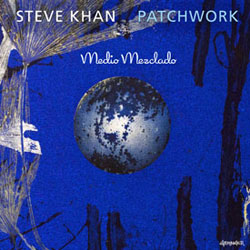 it is really a complex question. As one who loves Latin music and Latin Jazz, that does not necessarily qualify me to be the best person to answer this. No matter what I learn, and how much I study and improve, I am not a Latino, and my life experience is different. What I initially wanted to do with these recent recordings was to try to integrate the looseness and conversational playing style of Eyewitness with a real Latin percussion section. But, try as I might have, "PARTING SHOT," which included Anthony Jackson, Dennis Chambers and Manolo Badrena alongside Marc Quiñones and Bobby Allende, became something else, and I just could not realize that vision as desired. From that point forward, through the 3 albums that followed, I just wanted to play Latin Jazz, as I heard it, with the guitar as the main voice of the music, and in doing so continue to play as I always had. I wanted the full compliment of Latin percussion: timbal, conga, bongó and all of the hand percussion, plus bass and drums. In my view, this is what Latin music, whether it's Salsa or Jazz, should be - should sound like, and feel like. Too many however, the drum set would be unnecessary! it is really a complex question. As one who loves Latin music and Latin Jazz, that does not necessarily qualify me to be the best person to answer this. No matter what I learn, and how much I study and improve, I am not a Latino, and my life experience is different. What I initially wanted to do with these recent recordings was to try to integrate the looseness and conversational playing style of Eyewitness with a real Latin percussion section. But, try as I might have, "PARTING SHOT," which included Anthony Jackson, Dennis Chambers and Manolo Badrena alongside Marc Quiñones and Bobby Allende, became something else, and I just could not realize that vision as desired. From that point forward, through the 3 albums that followed, I just wanted to play Latin Jazz, as I heard it, with the guitar as the main voice of the music, and in doing so continue to play as I always had. I wanted the full compliment of Latin percussion: timbal, conga, bongó and all of the hand percussion, plus bass and drums. In my view, this is what Latin music, whether it's Salsa or Jazz, should be - should sound like, and feel like. Too many however, the drum set would be unnecessary!In this area of music, three of the most influential albums in my life were: "INVENTIONS AND DIMENSIONS"(Blue Note)(1963) by Herbie Hancock and featuring Willie Bobo, and "SOUL BURST"(Verve)(1966) by Cal Tjader with a very young Chick Corea on piano. When I heard those albums in the mid-'60s, I knew what I eventually wanted to do - and how I wanted to sound in that context - even though there was no place for guitar as the lead instrument in Latin music at the time - certainly not as I heard it. But, at that time, I never believed that I could actually do it. It was just a vision, a dream. One must remember that, on both of these albums some of the most important sounds of Latin percussion, of Latin music, Latin Jazz were not present! That is the great oddity here! A 3rd album, which does feature all of the essential Latin percussion sounds, that helped me to better focus on everything necessary was 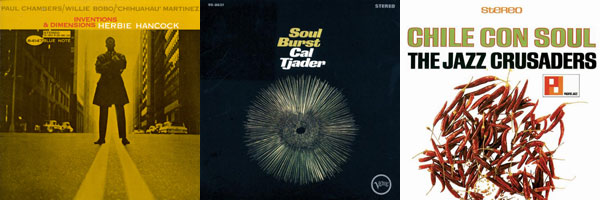 The Jazz Crusaders' "CHILE CON SOUL"(Pacific Jazz)(1965) featuring arrangements by Clare Fischer. The Jazz Crusaders' "CHILE CON SOUL"(Pacific Jazz)(1965) featuring arrangements by Clare Fischer.For me, the way I hear and feel things - I love sitting in the middle of these rhythms and sounds as performed by: Rubén Rodríguez(bass), Bobby Allende(conga), and Marc Quiñones(timbal & percussion). Then, when you add in the huge center provided by the great Dennis Chambers(drums), I am in the perfect spot for the way that I hear things. Yet, for most Latin Jazz purists, the drums would never be a part of such a mix. Pianist Oscar Hernández just released a great Latin Jazz album, Latin Jazz from start to finish, and there is only conga and drums, that's all - very little hand percussion if any. And the result is great Latin Jazz, period!!! In the hands of a masterful musician in the idiom like Oscar, or a Gonzalo Rubalcaba it's all possible. I am not at the level of these giants, but that doesn't stop me from trying to do something unique and special. [2] You started off as a drummer. How did that shape you as a guitarist? [SK] Well, let's try this for a response. Because I was not a very good drummer, it made me really appreciate the greatness in other drummers. And so, on all of my recordings as a leader, each of the drummers has been a great artist on his instrument: Steve Gadd, Rick Marotta, Steve Jordan, Dave Weckl, Al Foster, Dennis Chambers, Peter Erskine, Jack DeJohnette, and Mark Walker. But the drummers that I might not have been lucky enough to have used are drummers that I listen to, appreciate, and enjoy very much. That process never stops. As for the guitar? The mistakes that I made as a drummer, thinking that I could just play 'by instinct' - I did not want to repeat with the guitar. I wanted to be a musician, a better musician. In many ways, I worked very hard at that - but, in the end, my personality structure is pretty much the same, and my flaws as a person have affected my pursuit of excellence as a guitarist. I don't believe that I will ever be the guitarist that I would dream of being, but my career demonstrates that you can fall way short of your dream, and still accomplish something - sometimes, something of significance. This is why you just have to keep going, never stop, keep growing - as you can. [3] Who were some of your key guitar influences? [SK] The four main guitarists who served as the greatest influences for me were: Wes Montgomery, Kenny Burrell, Grant Green and Jim Hall. But, that stated, as a young person I listened to and loved all kinds of music from surfing music, to all the great R&B, and lots of areas of folk and rock music as well. The list of players would probably be bordering on endless. All of these players and more, including many of the usual suspects, are mentioned at the STEVE RECOMMENDS page at my site. [4] I'm interested in the influential concerts young musicians attended. What legendary guitarists did you see live when you were getting started - ones that made a huge impression on you? Do you recall any life-changing guitar shows? [SK] Growing-up in Los Angeles, mostly in the '60s, I was fortunate to have seen many great artists and bands playing. Of course, I went to hear Wes Montgomery playing whenever he would come to town - that was simpy awe-inspiring. San Francisco had the Fillmore West, and we had the Shrine Auditorium, where you could see 3 amazing bands on a given night for very little. I remember seeing Albert King, The Electric Flag with Mike Bloomfield, and, of course, Jimi Hendrix. Those were such great years to be young. [5] Your version of Ornette Coleman's "C. & D." sounds like you were having a blast. Describe the session? Was the track cut live? [SK] My particular process of preparing for these recordings, and "PATCHWORK" was no different, is to first make the best possible demos that I can. When this run of albums began with "PARTING SHOT"(2011), I don't think that I even owned Protools, and I needed the help of Rob Mounsey to prepare rather sketchy demos for Dennis Chambers. 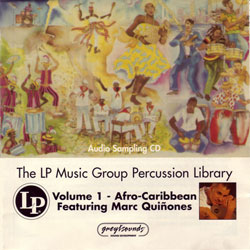 After that, I realized that I had to get Protools and to learn how to use it. I bartered some guitar lessons for Protools lessons, and used YouTube tutorials to get me started. It took quite some time, but I made big improvements in my skills leading up to "SUBTEXT"(2014). By the time that I was preparing for "BACKLOG"(2016), I was much less dependent upon Rob Mounsey's brilliant skills in that area of music. Where Latin music and these demos is concerned, I am only able to do the percussion in the best possible way - making the tunes really 'swing' - because of Marc Quiñones' brilliant CD, "LATIN PERCUSSION SAMPLES"(LP). After that, I realized that I had to get Protools and to learn how to use it. I bartered some guitar lessons for Protools lessons, and used YouTube tutorials to get me started. It took quite some time, but I made big improvements in my skills leading up to "SUBTEXT"(2014). By the time that I was preparing for "BACKLOG"(2016), I was much less dependent upon Rob Mounsey's brilliant skills in that area of music. Where Latin music and these demos is concerned, I am only able to do the percussion in the best possible way - making the tunes really 'swing' - because of Marc Quiñones' brilliant CD, "LATIN PERCUSSION SAMPLES"(LP).As Bob Mintzer lives in Los Angeles, Bob recorded himself @ Rich Breen's studio playing to my "C. & D." demo. This would never have been possible if the demo didn't sound great and feel great. So, fast forward to the recording itself, when all the guys come in to play: Rubén Rodríguez(bass), Bobby Allende(conga), Marc Quiñones(timbal & percussion), and Dennis Chambers(drums), Mintzer and Rob Mounsey have already recorded their performances. So, in theory, we are all playing as if what was pre-recorded is happening live. That is part of the art of this approach to modern recording. Your perception is a wonderful confirmation that we achieved the desired result, because in the end, it is all very serious, but we do have a lot of fun too. From the point-of-view of a purist, this is not at all the aesthetic of recording Jazz. Most of us would say that, you prepare, rehearse (if possible) the best that you can, and then you walk into the studio and play. What is captured on tape, or now in the computer, is a performance, a version of that tune that just happened that way, that time. It is meant to be left as it is - because that's what happened - flaws and all. This is what I grew-up believing - and, in many ways, I still believe in those principles. So, what I have done is completely contrary to that aesthetic. But, I am now operating under a different set of principles, where I feel that my responsibility is to the music as a whole. I do not seek 'perfection' in any way - I just want each piece of music to be realized in the best possible way - and heard in the best possible light. That can bring aesthetics and realities into conflict, a conflict that I have to resolve internally. [6] One thing that makes "PATCHWORK" so much fun is that it sounds great. What can you tell our readers about the importance of not just playing well, but also having a good sound. [SK] I'm going to interpret your question as if you are speaking about the audio aspects to "the sound" - that part of things is hugely important to me. If it must be stated, I don't think that there are ever any perfect sounding albums from a mixing/mastering or audio standpoint. As the producer, there are going to be errors in judgment or perception that will haunt me forever. 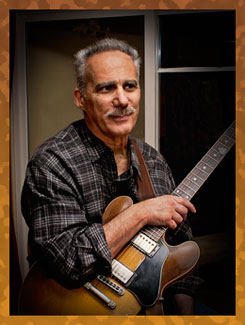 Often, they are small things, but they drive me crazy. However, there are audio standards that should always be considered and strived for. I always want to make recordings that are beautiful pieces of audio - if possible. I do everything that I can to make certain that the albums have a chance to sound great. Of course, some of that means that people, the listeners are expected to have a real stereo system on which to listen - to truly appreciate what we have done. These days, that would pretty much eliminate everyone. [Laughter] Very few people, especially young people, own a stereo system with components and speakers. There's not much that I can do about that - but, I know that these albums will sound good on a serious stereo system. Often, they are small things, but they drive me crazy. However, there are audio standards that should always be considered and strived for. I always want to make recordings that are beautiful pieces of audio - if possible. I do everything that I can to make certain that the albums have a chance to sound great. Of course, some of that means that people, the listeners are expected to have a real stereo system on which to listen - to truly appreciate what we have done. These days, that would pretty much eliminate everyone. [Laughter] Very few people, especially young people, own a stereo system with components and speakers. There's not much that I can do about that - but, I know that these albums will sound good on a serious stereo system.To achieve that? You have to have a great engineer and a great studio. I've been fortunate to have worked with both James Farber and Malcolm Pollack, and to have recorded at Power Station/Avatar, Sear Sound, Skyline (now Reservoir), and in another age, Mediasound - afterwards, to have been able to master the recordings with Greg Calbi @ Sterling Sound. All of these people and places contribute greatly to what you hear as the end result. [7] Your tone is very rich. What is your tone concept - are you trying to evoke horn-like tones, or is it something else? [SK] First of all, thank you so much! I think that most of the guitarists of my generation, and the generations that have followed, would all like to 'sound like' a horn - probably the tenor sax. So, there has been an emphasis on the elimination of picked strokes, playing more legato - and not having the rather stiff feeling that can occur for some players who pick every single note with alternate picking. Depending upon the player, it can be great, like a Pat Martino - but for far too many of the rest of us, it might not feel all that great. I suppose that, in an ideal world, we would all want to play like Pat Martino - but, most of us can't do it. Although, I would hasten to add that today's young guitarists are so technologically advanced that it's scary - and this has been true for a couple of decades. To begin, I have to say that, EVERYTHING on the guitar or any instrument is all about TOUCH!!! Where the flesh meets the string, and gently pushes it into the wood - that is where your sound is going to be defined. Players with a great touch are going to sound great - and others? Not so much! Like many players, also of my generation, playing an electric guitar, other than the traditional semi-hollow body Jazz guitar. like the Gibson 335, you can have the best of both worlds IF you choose to do so. Because I use such light gauge strings [which people never believe me when I tell them that] - a Dean Markley set where my high E-string is a .009 - I have to make-up for that in other ways. The most obvious way is to darken my tone by backing-off, WAY OFF, on the tone control. So usually, when I am playing live, my tone control can be as low as '4'! But when one is recording, you can't do that! Any great engineer will tell you that. The reason is simple. If you do that, you might have to then brighten-up the tone in mixing, and when you do that, you are adding 'noise' to your sound. So, the solution is that it is ALWAYS better to record yourself a little brighter than you would like, and then, you can darken it up a bit when you are mixing. So, with an engineer like James Farber, I have been recording with my tone control at about '7' now. We never argue about that, because I know that he's trying to bring out the best in me - and the music. The other thing that I have done over the many years is that the lighter I tried to pick, the gauge of my picks went-up. For years now, I have been using Fender Extra Heavy picks - and rather than accentuating the picked strokes - I actually now play much lighter. The final piece of the sound that I have been working at producing is actually how very LOUD I play! I don't know if this was a good decision or not, but when I bought my two Marshall #1966A 2x12" bottoms, I replaced the Celestion speakers with EV speakers, because that was recommended to me by Harry Kolbe at the time. Now when I listen to certain moments during the various solos on "PATCHWORK" and I hear a low note go by on the A-string or low E-string, all I hear is this big, full round tone, and the fact that the speakers NEVER crap out. Sounds like a simple thing, but that's what I'm going for - and believe me, I am pushing those speakers hard. If I was trying to have a little grit on my sound, I would approach things very differently. The last time I went with a sound like that, it was on the Stevie Wonder tune, "Go Home" from "BACKLOG"! I felt that that was the right approach for THAT song. [8] What gear did you use on the album? [SK] My GEAR has not changed all that much since the Eyewitness years during the early '80s. I've been playing the same Gibson 335 from 1982 and their "Heritage" Series. My guitar 'orchestrations' are done with my ESP Strat (w/ EMG pick-ups) and a simple Ernie Ball volume pedal. 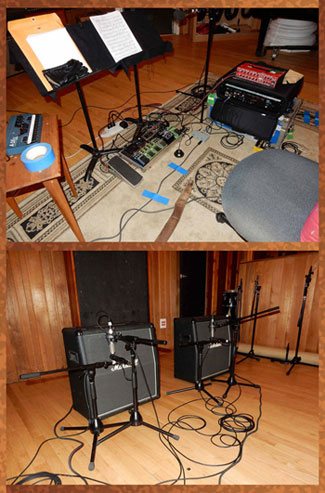 On the new album I also played my Martin MC-28 steel-string acoustic (on "Bouquet"), and my Yamaha APX-10N nylon-string (on "The Journey Home" and "Huracán Clare"). Though I discuss my gear in great detail at the EQUIPMENT page at my site, the essence of 'my sound' remains the Ibanez DCF-10 Digital Chorus/Flanger pedal. All of my settings can be found at that same page - though they seem to morph slightly from album to album. My pedalboard changed when Tom Peck modified it for me several years ago. Basically that DCF-10 is on all of the time, and I have 2 delays [Ibanez DDL pedals] ping-ponging [Left-Right] in a most subtle way, I hope. On the new album I also played my Martin MC-28 steel-string acoustic (on "Bouquet"), and my Yamaha APX-10N nylon-string (on "The Journey Home" and "Huracán Clare"). Though I discuss my gear in great detail at the EQUIPMENT page at my site, the essence of 'my sound' remains the Ibanez DCF-10 Digital Chorus/Flanger pedal. All of my settings can be found at that same page - though they seem to morph slightly from album to album. My pedalboard changed when Tom Peck modified it for me several years ago. Basically that DCF-10 is on all of the time, and I have 2 delays [Ibanez DDL pedals] ping-ponging [Left-Right] in a most subtle way, I hope.The other device that has become a signature part of my approach to playing is the Korg DVP-1 Harmonizer which sits off to my right in soft, black rack bag - just arm's length away, with an on/off switch right in front of me - all designed by Ralph Skelton, who was Joe Zawinul's keyboard tech when I was part of Weather Update. I am also supplying a link to another page at my site that shows you exactly how everything looked when I was recording "PATCHWORK," including James Farber's mic'ing set-up for my two(2) Marshall #1966A 2x12" bottoms. Though the sound might be 'clean' - I am actually playing really, really loud. I am "throwing some air"!!! [9] You and keyboardist Rob Mounsey, who appears here, worked on Steely Dan's "GAUCHO" album - the last work of their golden age. What do you remember of those sessions? [SK] Pete, as you know, Steely Dan fans are a really ravenous collection of people, and though I feel like a rather minor contributor in the galaxy of Steely Dan players, I still get asked questions like this all the time - even though almost 40 years have passed. In order to best answer them all, eventually, I decided to create two separate pages at my website: [1] Reflections on Steely Dan's "AJA" and [2] Reflections on Steely Dan's "GAUCHO." In each one, I tell all the stories that are 'fit to print' - and throw-in some other stuff as well. If someone likes to read, whatever it is that I know, and/or experienced, it's all pretty much there. I have supplied you with both of the links. [10] In the late 1970s, there was a very distinct jazz-fusion sound from New York City - it was less about chops and more about funk and groove. What do you remember about that era of guitar playing, through the lens your great fusion albums, "THE BLUE MAN"('78); "TIGHTROPE"('77) and "ARROWS"('79)? [SK] The main thing for me, during those years, was that I wanted very much to somehow keep the sound of the original Brecker Bros. Band, with the 3 horns, Randy Brecker, Michael Brecker, and David Sanborn together - just in a bit more guitar-centric presentation. I tried my best to do that. Back then, I was playing a hot-rodded Tele with a humbucker in the neck position. I have a hard time listening to those albums now - but, the beautiful feedback I get from older fans, who have been with me all of these years - and then, a whole bunch of new, younger fans - this is most heartening for me. I have no idea what they hear in that music now - but that they hear 'something' is really great. What I have become since then, I really owe it all to having formed Eyewitness with Anthony Jackson, Steve Jordan, and Manolo Badrena in 1981. We made 3 albums together, and those recordings changed my life. Everything that has come thereafter is just an extension of those music-making concepts that we explored back then. [11] Will you be touring with "PATCHWORK"? [SK] The short answer is, "No!" For years, decades, without a manager or a 'muscular' booking agent, I tried to play live and to tour. I felt like I did everything that I could. For a time, it seemed as though the only things that I could do, and come close to breaking even, financially speaking, was to go to Japan, or play in Europe - and I was most fortunate to have done both of those things. Playing in my own country was much more problematical for me. For example, if I wanted to play a 2-week run of the northeast: Washington, DC, Philadelphia, New York, and Boston - with some other cities/venues filling-in the open dates, I would probably personally lose from $10,000 to $20,000. And worse than that, I would still feel as though I was not paying the bassists and drummers what they were worth or deserved. It was an awful feeling. Eventually, I just gave-up on that dream, feeling that it was NOT going to happen for ME! Period. So, I made the huge decision that, IF I was going to lose money, I would rather lose my life's savings, step-by-step, making recordings that meant everything to me - and that, in theory, the music would last forever. So, simply put, that's what I have been doing, or trying to do. Now, with "PATCHWORK," and my savings at DEFCON 5, this is probably it for me. I know that I cannot self-finance another recording. [Photos: Steve Khan @ Sear Sound - Photo by: Richard Laird |